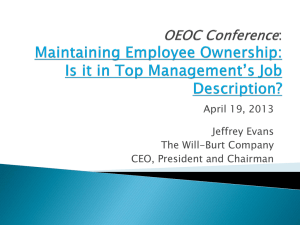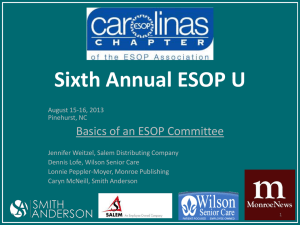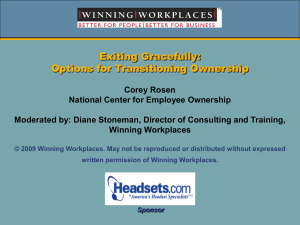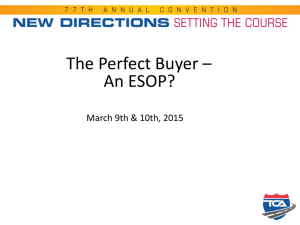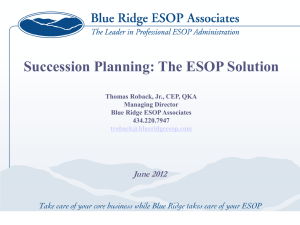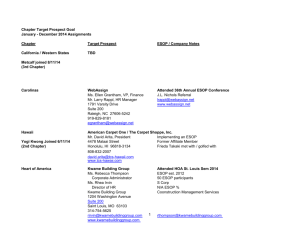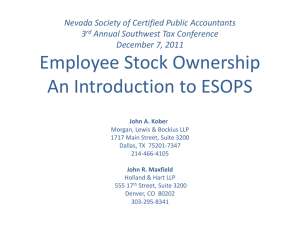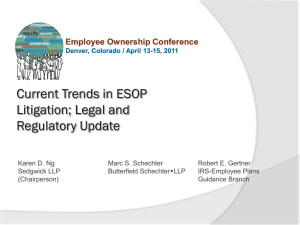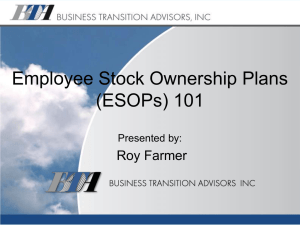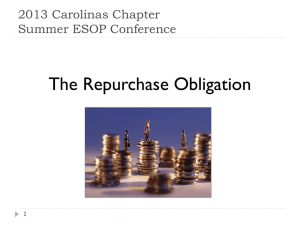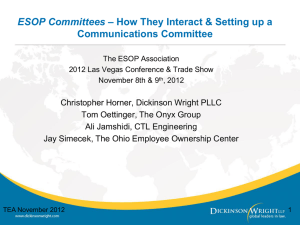Beacon-Hill-Employee-Ownership
advertisement
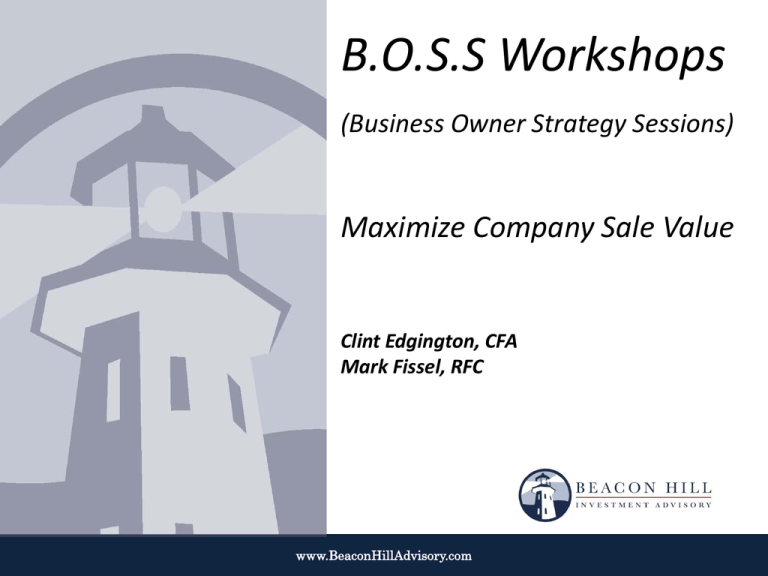
B.O.S.S Workshops (Business Owner Strategy Sessions) Maximize Company Sale Value Clint Edgington, CFA Mark Fissel, RFC www.BeaconHillAdvisory.com Roy Messing Ohio Employee Ownership Center Kent State University 113 McGilvrey Hall Kent, OH Beacon Hill Investment Advisory Columbus, Ohio March 18, 2010 Outline Overview of Reasons for Employee Ownership Management Buyout vs. Employee Buyout Recognizing Good Candidate Companies for Sale to Employees ESOPs vs Employee-Owned Coops Costs Provisions Steps for an Employee Buyout 3 Uses of Employee Ownership Owner Driven Succession Planning Competitiveness Strategy Tax Advantaged Corporate Financing Employee Driven Averting a Plant Shutdown Securing Job and Career 4 Reasons for Employee Ownership (multiple reasons possible) averting shutdown or major job loss ownership succession divestiture of plants & divisions blocking a takeover or purchase by another company financing expansion of company reducing borrowing costs replacement of another benefit plan additional benefit plan philosophical commitment to employee ownership 44% 5% 58% 11% 6% 10% 15% 10% 35% Source: Real World of Employee Ownership (2001) 5 Management Buyout vs. Employee Buyout via ESOP or Coop Common Characteristics: Buyers have small amount of funds available Buyers must use borrowed funds Assets of company used as collateral Future cash flows of company used to repay debt 6 Management Buyout vs. Employee Buyout via ESOP or Coop Buyers Tax Incentives Sale or Gift Management ESOP/Coop Key Managers None Sale All Employees Several Gift --NO! –It’s a Sale! 7 Recognizing Good Candidate Companies for Sale to Employees Profitable business No family members involved in the business Employees see jobs as worth having and business as worth owning – high seniority Owner and employees regard each other as “family” Owner has 3-7 years to implement ownership succession Partnership between owner and employees for this period is seen positively by both 8 Recognizing Good Candidate Companies for Sale to Employees Owner willing to sell to employees Capable management succession team in place Assets available to serve as collateral Future cash flows are predictable Company has ability to handle additional debt likely it can obtain financing Sufficient time available to do the transaction 9 Recognizing Good Candidate Companies for Sale to Employees Number of Employees: 30 ESOP can usually be justified 20-30 depends on the specific situation < 20 ESOP very difficult to justify, Employee-Owned Coop more appropriate 10 Set Up Costs Attorney Valuation Trustee – External Trustee – Internal Administration ESOP $20,000 8-12,000 10-25,000 -0-0- EO Coop $20,000 6-10,000 N/A N/A N/A 11 Ongoing Annual Costs Attorney Valuation Trustee – External Trustee – Internal Administration ESOP $5-10,000 5-8,000 10-25,000 -04-7,000 EO Coop $5,000 -0N/A N/A N/A 12 Lesson re Costs KISS Simple Plan Lower Costs Complex Plan Higher Costs Coops are less expensive than ESOPs Coops are preferred for companies with < 20 employees 13 ESOP vs. Coop ESOP EO Coop Protected by ERISA Yes No Capital Gain Tax Deferral Available to Seller for Sale to Employees (1042 Rollover) Yes Yes Transaction Valuation Required Yes Yes Annual Valuation Required No Yes 14 ESOP vs. Coop ESOP EO Coop 1 Vote = 1 Share 1 Person Voting on Normal Issues Trustee, Direct Direct is optional Voting on Major Issues Direct Direct Board Selection/Election Many Majority must be methods are elected by acceptable members 15 ESOP vs. Coop ESOP EO Coop Employee Payment Not usually Yes Membership Fee $-0- $300-30,000 Membership Optional? Automatic if eligible Yes, not required Normal Payment of Ownership Benefit After Termination While employed, 8-15 Year Cycle Payment to Employee Valued at Fair Market Value Book Value 16 ESOP vs. Coop Ownership of < 100% of company: ESOP: Any % ownership is viable long-term Coop: Only 100% ownership is viable long-term Company is either a coop or it’s not – can’t be a partial coop Coop: HOWEVER, < 100% ownership is acceptable during transition period of Coop being in process of purchasing 100% 17 ESOP Tax Incentive for Seller Sale to Management or Outside Buyer Proceeds $1,000,000 Capital Gain 1,000,000 Capital Gain Tax @ 15% 150,000 Net to Seller 850,000 Sale to Employees through ESOP $1,000,000 1,000,000 -01,000,000 18 ESOP Tax Incentive for Company Sale to Management or Outside Buyer ESOP Loan $1,000,000 Principal Repayment 1,000,000 Tax Deductible? Tax Deduction @ 34% Net Loan Cost No -01,000,000 Sale to Employees through ESOP $1,000,000 1,000,000 Yes 340,000 660,000 19 Why Sell to an ESOP? Sale to Management Sale to Employees or Outside Buyer through ESOP Selling Price $1,000,000 $1,000,000 Tax Savings: Capital Gains Tax -0150,000 Principal Deduction -0340,000 Total Tax Savings -0490,000 20 Transaction Reality The tax incentives available to an ESOP and Employee- Owned Coop often make the transaction “doable” that without the tax incentives is not “doable”. 21 Time Required Retiring Owners may “percolate” the idea for years before deciding to implement the Succession Plan Typical time required to implement: ESOP: 6-9 months Coop: 4-6 months Quickest time seen: ESOP: 10 weeks Coop: 4 months (limited experience) 22 Steps for an Employee Buyout Educate seller & key employees about ESOPs and/or Employee-Owned Coops Alert parties, especially seller, to fiduciary responsibility Obtain “ballpark estimate” valuation of business No sense continuing if valuation is unacceptable to selling owner Establish buyout committee Conduct preliminary feasibility study Educate employees about buyouts 23 Steps for an Employee Buyout (cont’d) Prepare business plan Obtain final business valuation for transaction Negotiate sales agreement with seller Develop & approve official ESOP or Coop Plan documents Arrange financing Close deal & celebrate! 24 Employee Ownership Summary Significant tax advantages Flexibility Employee Ownership + Ownership Culture linked to improved company performance Successful succession planning Not suitable for all circumstances 25 Contact Information Roy Messing rmessin2@kent.edu 330-672-0333 Ohio Employee Ownership Center Kent State University 113 McGilvrey Hall Kent, OH 44242 www.oeockent.org 26 Our Clients’ outperformed in Good times and Bad! www.BeaconHillAdvisory.com
